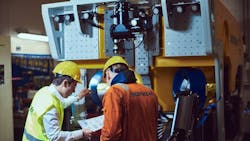NEW RELEASE:
Offshore Business Strategies Special Report 2025
This 2nd annual special report, published in June, shares insights from industry experts on how to navigate an evolving marketplace and the best tactics being utilized in the offshore oil and gas sector.
DeepOcean is adding eight new ROVs to its global fleet of almost 60 vehicles.
Three have already been delivered, with the other five due to arrive over the next four years, with others available as options.
One focus of the program has been step up adoption of modern electric ROV (eROV) technology to support more sustainable subsea operations, the company said.
Kystdesign is providing seven of the new ROVs, including two of those already delivered. Both Constructor-series work class ROVs (WROVs) have been mobilized on the revamped Island Ocean subsea vessel, which is due to join DeepOcean’s fleet later this year.
Two similar Constructor WROVs should be delivered and mobilized next year on the Orient Adventurer vessel.
In addition to the four conventional ROVs, Kystdesign will provide two new electric WROVs and one electric observation ROV, to be mobilized onboard the REM Ocean newbuild in 2027.
The agreement includes options for a further eight electric WROVs and five observation ROVs.
Argus Remote Systems delivered DeepOcean’s first electric work class ROV early last month. It will be installed on the USV Challenger uncrewed surface vessel.
The fully electric WROV with hydraulic capabilities can operate in water depths down to 1,500 m, with a tooling package to support a wide range of subsea operations, including operations remotely from the shore.
DeepOcean’s existing ROV fleet operates in the Asia-Pacific, Europe, Africa and Americas regions, providing inspection, maintenance and repair; construction; survey; and removal and recycling of subsea structures.
To support subsea inspection work, the new ROVs will be equipped with the same software integration as DeepOcean’s existing autonomous inspection drone, allowing the ROVs to perform pre-programmed inspections of subsea assets.
A key feature is the company’s digital twin platform in which a model of the ROV is controlled. In seabed areas where visibility is low, the ROV operator can instead opt to fly and operate the ROV using the digital twin.
Want more content like this?
- Visit the Subsea section for more offshore news, project updates and technology trends; or
- Subscribe for free to the monthly Subsea Report e-newsletter.
